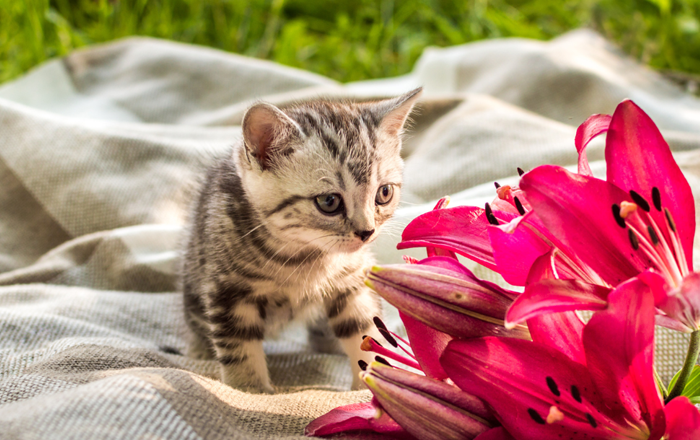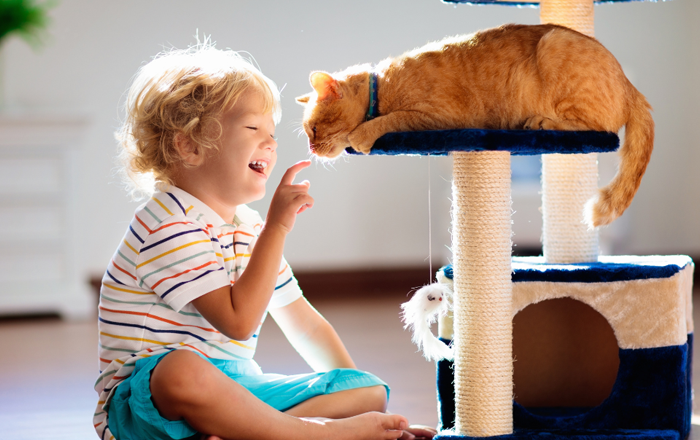Adding a new kitten to the family is so exciting, they’ve got such cute faces and funny personalities! I love the way cats are independent but affectionate, entertaining, and MASTERS in relaxation. Having a purring cat on your lap is incredible stress relief.
Though cats need less training than dogs, there are still some critical things you should do to prepare for your new kitten, and help them settle in happily to life with you.
1. Get set up with the gear
Make sure you have all the essentials before your kitten comes come. My list includes:
- Cat carrier
- Comfy beds (kittens spend most of the day sleeping!)
- Scratching post (it may help spare your furniture!)
- Food and water bowls, many cats prefer to drink water when it’s away from their food dish so don’t buy all-in-one food and water bowls
- A puzzle feeder would be a bonus
- Engaging toys to keep your kitten entertained, especially since they’ll be inside for at least 8 weeks, a flirt pole is a must
- A collar with bell
- A deep litter tray with unscented litter and a scoop
- Age appropriate food and treats
- White vinegar, a non-toxic way to neutralise urine smells in case of any accidents
If you’re going to allow your cat to have outside access, install a cat door. This isn’t needed urgently as your kitten should be established inside your home for 2-6 weeks before being allowed outside, to give ample time for it to become their home territory.
If you are going to have a full time indoor cat, you may like to think about creating a catio (contained outdoor space). But this isn’t urgent!
Some people may also choose to get a harness and lead, so they can train their cat to go for walks.

Mark Vette is a world-renowned Animal Behaviourist, Zoologist and Trainer. He brings together a unique combination of academic studies with 40 years of applied clinical animal behaviour consulting and treatment. Mark is a member of the International Association of Animal Behaviour Consultants. This article was written by Mark and the views expressed are his own.
2. Set up a safe zone
Kittens needs a quiet, safe space to come home to so they can settle in without becoming fearful and overwhelmed. Having this dedicated space also helps with house training and teaching your kitten about their new home territory.
Set up one small room for your new cat, a bathroom or laundry often works well. It should be quiet, secure, well ventilated and a comfortable temperature. Cats like to be up high, so include a cat tower or some vertical spaces that your kitten can get to.
Include in the room a litter tray, food and water, toys, a bed, and a small dark space for your kitten to hide in. Kitten proof it carefully, see next item…


3. Kitten proof your home
“Curiosity killed the cat”, right? This quote exists for a reason! Kittens are curious little creatures that love to play and explore, and it can get them into trouble.
Before you bring your kitten home, clear away or safely store any items that could cause harm such as chemicals, cords, string, electrical cables that could be chewed through, and dangerous plants. Many common plants and flowers are toxic to cats (check out a good list here), a friend of mine tragically lost her precious cat after he got into a vase of lilies on the kitchen table, which are one of the most dangerous and cause acute kidney failure. But along with lilies, be aware of other indoor plants and flowers like oleander, philodendrons, monstera, aloe vera, snake plants, fiddle leaf figs, rubber trees, jade plants, Madagascar dragon trees, yuccas, sago palms, birds of paradise, gladiola, hydrangeas, ivy and tulips.
Keep toilet lids shut as they present a small drowning risk, and make sure human foods are kept safely stowed away as many are toxic to cats.
Also consider any breakable ornaments that could be pushed off their ledges by a mischievous cat.
4. Help your kitten settle in happily
Keep things calm and quiet for your new kitten to begin with, to help them settle into your home happily - avoid loud noises, we don’t want them to get any big frights in their new home!
Bring your kitten into their room and shut the door before you let them out of their carrier as they may be fearful after the car ride and try to scarper.
Keep them in this one room for 2-3 days, it helps them feel safe and secure and establishes that space as their own territory. It’s also easier for toilet training and cleaning up! Gradually open up one extra room to them at a time after this initial three day period. Save introductions to other pets until after the initial three day period too.
After 6-8 weeks, you can start to do supervised visits in your backyard and after 8-12 weeks you can begin allowing free access outside. Don’t give your cat access outdoors until they are microchipped and desexed though, there are enough kittens in animal shelters across the country already! I also recommend shutting your cat inside in the early evening each night, dawn and dusk are a cat’s most prolific hunting times so this will protect our native birds. A quick release collar and bell may also help reduce the impact on native birdlife.
If you live on a busy road or have a large local native bird population, you may choose to keep your cat exclusively indoors. This is absolutely fine, provided your kitten has plenty of toys and stimulation available in the house. You can also install cat proof fencing or a catio to give your cat a safe, contained outdoor space to go in and cats can also be trained to wear harnesses and walk on lead for outings.
5. Socialise your new kitten
Moving to your home may be overwhelming for your kitten so don’t force too much attention on them for the first few days. It’s okay if they’re hiding a little during this period.
Introduce one person from the family at a time and be patient - allow your kitten to build their comfort with you and let them decide when they’re ready for contact. Be particularly mindful about managing excited children, and teach children how to be gentle and respectful to your new pet. Remember cats prefer to be petted on their cheeks, so start by handling them here.
Other pets should be introduced carefully, one at a time, with your kitten in a crate to begin with. If you have concerns about another pet’s behaviour to your new kitten, consult a behaviourist.
Once your kitten is nicely settled in and confident with the family, extend their socialisation to other people so that they become more broadly relaxed with humans. Cats are naturally solitary species, so they need lots of positive contact with humans during their 3-9 week formative period in order to feel relaxed and happy in our human world.
During this period of rapid cognitive and social development, kittens should also be given exposure to friendly dogs and other household pets like rabbits, guinea pigs and chickens. This is also the key time to help your kitten get used to being handled and petted, crating, fireworks and thunder noises, car travel, unfamiliar noises and harness training if you’re going to do that. Basically, whatever you want your cat to be relaxed about as an adult - introduce it to them in a positive way when they’re a kitten.

Enjoy!
Most of all, enjoy that beautiful little creature that’s become a part of your family.
Always consult your vet on the best way to look after your pet. And to avoid unexpected costs, make sure your pet is insured.
Have a look at our pet insurance plans to choose the right insurance plan for your pet.
